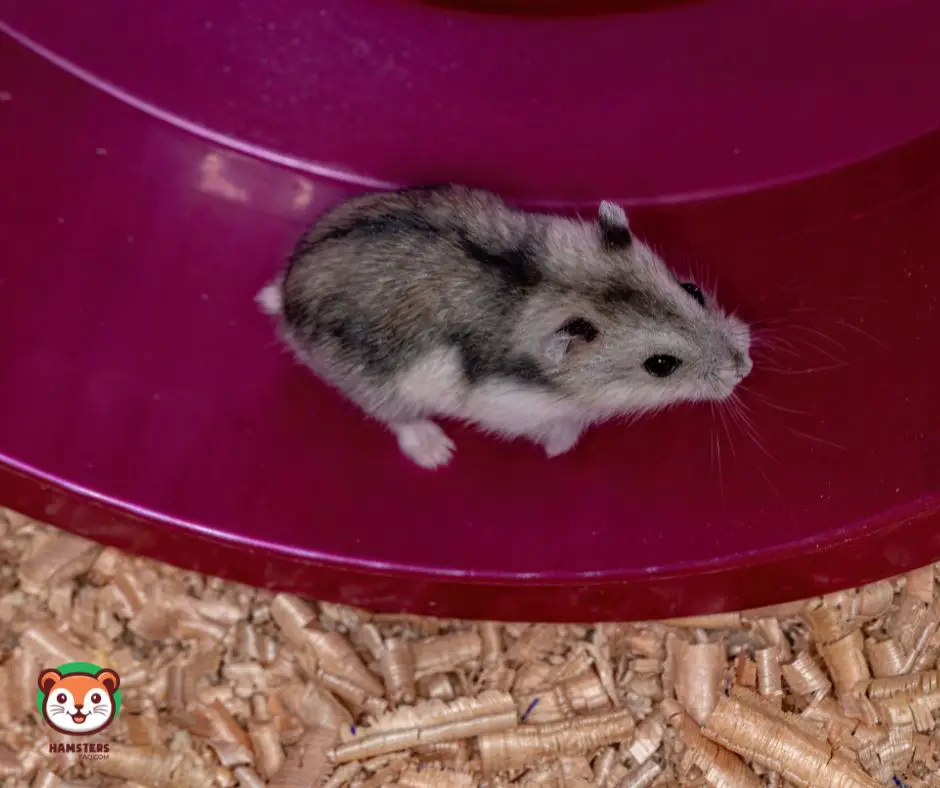Dwarf hamsters have so many wonderful qualities that make them great pets, but one of their most unique features is their ability to run on a wheel. It’s like a hamster marathon.
But if you’ve ever put a dwarf hamster on its wheel and found that it’s not big enough, then you’ll know how frustrating it can be when your pet doesn’t get the exercise they need.
Luckily there are some things you can do if you find that your dwarf hamster isn’t getting the workout they need from its cage’s wheel; with these things, you will also know how big of a wheel does a dwarf hamster need.
A dwarf hamster’s wheel should be 8 to 10 inches in diameter. As with many things in life, the size of your hamster’s wheel is important.
Anything smaller than 3-10 inches will be too small for your pet, and anything larger may not fit in their cage. Keep in mind that wheels can vary from brand to brand, so make sure you measure the diameter before choosing one.
Table of Contents
How To Know If Your Hamster’s Wheel Is Not Big Enough?
There are several signs that your hamster needs a larger wheel, including:
If the wheel is too small, your hamster will not be able to run around in it and may get stuck in it. This can cause injury or death.
A particularly small wheel for a Syrian hamster is about 8 inches in diameter, but some dwarf varieties need even more space.
If the wheel has too few rungs for your pet’s weight and size, he might slip off and fall below. Hamsters can die from such injuries.
What Should You Consider Before Buying a Hamster Wheel?
There are several things you should consider before buying a hamster wheel:
1. Size
Choosing the right size for your hamster and its cage is important. The diameter should be at least 8- 10 inches wide, so your pet has enough space to move around comfortably while running around in circles.
The wheel’s height should also be considered, as some models can be adjusted according to your pet’s height when it’s on all fours or standing up on its hind legs.
2. Materials
There are many materials that can be used to make hamster wheels. The most common types of materials are plastic and metal.
Plastic wheels are generally easier to clean and less expensive. However, they may not be as durable as metal ones and can be more dangerous for your pet’s health if they chew on them.
Metal wheels are heavier and sturdier than their plastic counterparts. They also tend to last longer and allow for higher speeds because of the larger diameter.
However, their porous surfaces are also heavier and harder to clean.
3. Style
There are several different styles of hamster wheels on the market today. The most common style has a solid base and a track around it.
Other options include plastic bases with a wire mesh surface that your hamster can run on or large exercise balls in which your pet can roll around.
4. Safety Features
You want a hamster wheel that’s safe for your pet. Check for any sharp edges or protrusions that could hurt your hamster if it runs into them while using it.
Also, look for handles on either side of the wheel so that you can easily pick up or move it without having to touch any part that might hurt your hands or fingers (like sharp wires).
5. Durable construction
Another important consideration is whether or not your chosen model will last long enough to provide years of enjoyment for your pet.
The best way to ensure this is by choosing one made from durable materials like plastic or metal instead of cheap plastic ones that break down quickly and may even hurt your pet if they fall off while running on them.
What Are The Alternatives To Hamster Wheel?
Here are some of the most popular alternatives to the hamster wheel:
1. Treadmill
A treadmill is an excellent alternative to using a hamster wheel. It allows your pet to walk or run at his own pace while still keeping him confined in one place.
Treadmills are available at most pet stores, though they may be more expensive than traditional wheels because they include more features than just an exercise wheel.
2. Bounce house
A bounce house can provide hours of fun for you and your pet. You can set up the bounce house in any room of your home and let your hamster play inside it whenever he wishes.
You could even put treats inside the bounce house so that he has something to do while waiting for you.
3. Hamster ball
A hamster ball is a toy that you can play with your hamster or other small animals. It is usually made of plastic and has air holes so your pet can breathe while playing inside it.
The ball allows your pet to run around, jump and play in the house without hurting itself or others.
4. Maze toys
These toys come with various obstacles and tunnels for your hamster to explore and use as exercise. The best ones contain food that encourages your hamster to run around more, which is good for both their body and mind.
5. Hideouts
Hamsters like to feel safe, so ensure you have plenty of hideouts in their cage. You can buy them or make your own out of plastic bottles or paper towel tubes.
Some hideouts are often made out of cardboard boxes or other materials that can be purchased at a local hardware store. They should be tall enough for your pet to fit in easily and have plenty of room for them to climb around while they explore the hideout.
Conclusion
All in all, these are just the basic things to consider when selecting a wheel for your dwarf hamster. There are plenty of other factors to consider, such as the wheels’ designs and their sturdiness.
It’s also important to understand that hamsters get bored easily, so try more than one design to avoid having your hamster not use its wheel for long periods.
Still, this guide will give you a solid place to begin your search for the best wheel for your pet dwarf hamster.

